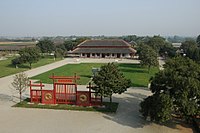Main articles: History of China and Timeline of Chinese history
| History of China | |||||||
|---|---|---|---|---|---|---|---|
| ANCIENT | |||||||
| Neolithic c. 8500 – c. 2070 BCE | |||||||
| Xia dynasty c. 2070 – c. 1600 BCE | |||||||
| Shang dynasty c. 1600 – c. 1046 BCE | |||||||
| Zhou dynasty c. 1046 – 256 BCE | |||||||
| Western Zhou | |||||||
| Eastern Zhou | |||||||
| Spring and Autumn | |||||||
| Warring States | |||||||
| IMPERIAL | |||||||
| Qin dynasty 221–206 BCE | |||||||
| Han dynasty 206 BCE – 220 CE | |||||||
| Western Han | |||||||
| Xin dynasty | |||||||
| Eastern Han | |||||||
| Three Kingdoms 220–280 | |||||||
| Wei, Shu and Wu | |||||||
| Jin dynasty 265–420 | |||||||
| Western Jin | |||||||
| Eastern Jin | Sixteen Kingdoms | ||||||
| Northern and Southern dynasties 420–589 |
|||||||
| Sui dynasty 581–618 | |||||||
| Tang dynasty 618–907 | |||||||
| (Second Zhou dynasty 690–705) | |||||||
| Five Dynasties and Ten Kingdoms 907–960 |
Liao dynasty 907–1125 |
||||||
| Song dynasty 960–1279 |
|||||||
| Northern Song | Western Xia | ||||||
| Southern Song | Jin | ||||||
| Yuan dynasty 1271–1368 | |||||||
| Ming dynasty 1368–1644 | |||||||
| Qing dynasty 1644–1912 | |||||||
| MODERN | |||||||
| Republic of China 1912–1949 | |||||||
| People's Republic of China 1949–present |
Republic of China (Taiwan) 1949–present |
||||||
Prehistory
Main article: Chinese prehistory
Archaeological evidence suggests that early hominids inhabited China between 2.24 million and 250,000 years ago.[42] The hominid fossils of Peking Man, a Homo erectus who used fire,[43] were discovered in a cave at Zhoukoudian near Beijing; they have been dated to between 680,000 and 780,000 years ago.[44] The fossilized teeth of Homo sapiens (dated to 125,000–80,000 years ago) have been discovered in Fuyan Cave in Dao County, Hunan.[45] Chinese proto-writing existed in Jiahu around 7000 BCE,[46] Damaidi around 6000 BCE,[47] Dadiwan from 5800–5400 BCE, and Banpo dating from the 5th millennium BCE. Some scholars have suggested that the Jiahu symbols (7th millennium BCE) constituted the earliest Chinese writing system.[46]Early dynastic rule
Further information: Dynasties in Chinese history


No comments:
Post a Comment